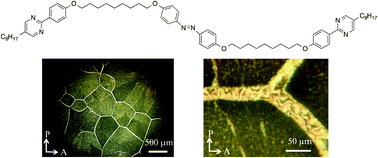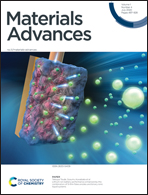Photo-induced guest–host interactions produce grain boundaries between smectic blocks†
Abstract
Photo-induced isomerization of an azobenzene unit not only induces phase transition between two different phases but also brings marked changes in the physical properties of solids. We prepared a symmetric trimer possessing an azobenzene unit, 4,4′-bis{9-[4-(5-octylpyrimidin-2-yl)phenyloxy]nonyloxy}azobenzene (I), and investigated the phase transition behaviour of trimer I and that of its binary mixture with a host liquid crystal. Trimer I exhibited three crystalline phases on cooling. Photo-induced isothermal crystal–liquid transition occurred only in the highest temperature crystalline phase through the trans–cis isomerization of the azobenzene unit. A binary mixture of trimer I (20 wt%) and a host liquid crystal (80 wt%) was found to exhibit grain boundaries consisting of nematic liquid crystals between smectic C blocks during a cooling process under UV irradiation. We explain the phase separation in terms of guest–host interactions between the photoinduced cis-trimer and its surrounding host liquid-crystalline molecules.



 Please wait while we load your content...
Please wait while we load your content...